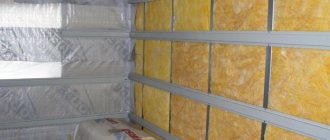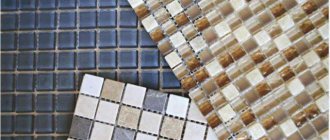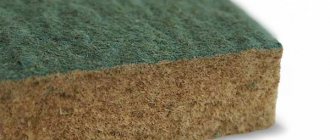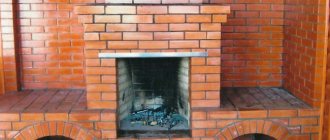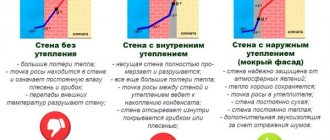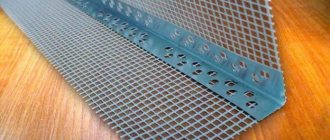When finishing external and internal walls, lime mortar is used. Despite the fact that construction stores offer various modern mixtures for finishing work, this composition is worthy of attention. Let's consider what types of lime mortars are used in each specific case, how to prepare them correctly, and what you need to remember when working with lime.
Lime plaster Source yandex.net
Lime: properties and applications
The positive properties of lime are strength and high adhesive ability. One of its main advantages is its rather low cost, which will ultimately affect the overall construction budget.
Lime added to the plaster solution has antiseptic properties, preventing the formation of mold and mildew on the surface of the walls.
The most important property of lime is its plasticity, which binds all the components of the batch into a homogeneous mass. The finest particles of calcium hydroxide are able to hold water on a rough surface, which reduces friction between the components, creating a so-called “lubricant”. Lime is added to the batch instead of synthetic plasticizers.
There are several basic recipes for preparing the mixture. But before using them, you need to figure out how to extinguish lime.
Lime slaking before mixing
To prepare various types of emulsions, slaked (hydrant) lime - calcium hydroxide - is used. First, it should be extinguished with water. To do this, take a container of a suitable size, for example, a barrel or trough. The container must be rust-free metal, wood or plastic.
Slaking lime in metal containers Source orchardo.ru
Considering that the mass after slaking will increase significantly, the container is taken three times larger than the original volume of quicklime. To slak large quantities of lime, a hole is prepared in the ground. Lumps of lime or ground powder are placed in the container and filled with a sufficient amount of water.
Attention ! When combined with water, a chemical reaction immediately begins - the lime begins to boil rapidly, so you need to be careful not to get burned. Safety measures include special protective clothing, rubber or silicone gloves, and safety glasses.
During the hydration process, cold water is used in the following proportions:
- Extinguishing the fluff – 1 liter of water per 1 kg of lime;
- Slaking of the “dough” - 0.5 liters of water per 1 kg of lime.
Vigorous boiling continues for 36-48 hours, the mass is thoroughly mixed several times. Once hydrated, let sit for two weeks before passing through a sieve to remove any lumps. The hydrant mixture is ready for use.
Lime slaking Source infourok.ru
Adding water
Water in cement mortar performs 2 main functions:
- Provides adhesion of ingredients. As a result of a chemical reaction, the solution hardens.
- Gives the mixture fluidity, which simplifies the process of laying and pouring the material.
The proportions of water are calculated individually: depending on the type of cement and fillers. Excessive amounts of water can adversely affect the quality of the mixture and cause air bubbles to appear after the liquid evaporates.
Preparing sand for preparing lime mortar
Several types of sand are used at construction sites:
- River.
- Career.
- Crushed mining waste.
- Quartz sand is used for textured or artistic plaster.
- Barite - for medical institutions and for protecting walls from background radiation.
Sometimes, instead of sand, marble chips are used as filler for decorative surface finishing.
Sand is selected taking into account the fraction and shape of the grains. Coarse grain interspersed with shells is not suitable for forming and leveling walls.
Quarry with a small addition of clay will be an ideal filler for cement-lime plaster. The small cross-section and irregular shape with sharp edges contribute to good adhesion to the surface. A small percentage of clay will prevent the emulsion from settling quickly.
Before mixing, the sand is sifted through a fine sieve with a fine mesh of 3 to 5 mm. This fraction is suitable for starting plaster. For finishing, sift through a sieve with a mesh size of 1-1.5 mm. In the process, pebbles, shells and other foreign inclusions of the large fraction are eliminated. Shell inclusions are suitable for exterior decoration of facades.
River sand, sifted through a sieve Source www.stroyportal.ru
In what sequence is kneading carried out?
As a rule, regardless of the proportions, the standard composition is prepared as follows:
- Pour a layer of sand and cement into the container in which the components will be mixed. Sometimes, before starting kneading, some people wet the container with water. This trick avoids waste generation.
- Mix all the ingredients and sift the dry mixture through a sieve.
- Continuously stirring the mixture, add a small amount of water. If you pour too much liquid, it may deteriorate the characteristics of the finished composition.
- Continue mixing for another 3-5 minutes.
- Let the solution sit for a bit so that all the components mix better.
Healthy! During the brick laying process, it is necessary to periodically mix the mortar. Otherwise, it will begin to delaminate.
If we talk about specific proportions and materials used, then it all depends on what kind of solution you plan to prepare. There are a large number of their varieties, so we will consider the most common ones, as well as their scope of application based on the viscosity of the compositions.
Types of lime mortars
In practice, several mixtures with lime are used:
- Gypsum-lime;
- Lime-clay;
- Cement-lime;
- Terrasite.
The most common cement. With gypsum, the emulsion is used for finishing, when a perfectly flat surface and quick drying are required. And they are used with clay quite rarely - for stoves, fireplaces and mud huts in rural areas. For each recipe, it is necessary to select and prepare all the components.
A type of lime mortar Source talkdevice.ru
Gypsum for mixtures
Lime-gypsum mortar for plastering walls is used only indoors with low humidity.
Advantages of gypsum plaster
This coating is used on ceilings due to its low mass. The walls are covered with a layer of about 5 mm, this allows you to consume significantly less material than when using plaster mortar with cement.
Advantages of coating with this composition:
- Easy vapor conductivity - moisture does not accumulate under the layer of material, good ventilation is ensured.
- After finishing, no varnish, paint or wallpaper is required, as the wall becomes smooth and neat.
- Fire safety - gypsum is not flammable. Therefore there is no risk of fire.
- High plasticity - the mass easily stretches, which is why the wall is covered with a thin layer, reducing material costs and labor costs.
- When heated and wet, no toxic components are released, because the mass consists only of natural ingredients.
Properties of gypsum Source presentacii.ru
Preparation of the solution
Proportion of gypsum mass:
- Dry gypsum powder – 1 part.
- Lime mortar for plaster – 3 parts.
The ingredients are pre-mixed dry in a proportion of 1 part of gypsum to one part of lime. Then both components are mixed to obtain an emulsion.
Preparation of mass from gypsum and lime Source sevparitet.ru
See also: Catalog of construction companies that specialize in finishing and facade materials.
After mixing, the emulsion is transferred to the wall for half an hour. The area is divided into small sections, and the mixture is diluted with water in small portions. If the time is overdue, the batch will have to be thrown away because it will harden and become unusable. On a vertical plane, the mass hardens very quickly, so it must be leveled immediately.
To increase the drying time, drying oil is added to the composition.
Lime-clay coating
For mixing, clay, sand and lime are used. The proportion depends on the fat content of the clay, which has different properties in each area.
Advantages of simple clay coating
Advantages of clay coating:
• Ease of operation.
• Availability of materials.
• Cheap.
• Thermal conductivity.
• Suitable for people suffering from allergies, as it absorbs all odors, leaving the air in the room clean.
Due to the fact that this method is used only at home in the private sector, the preparation and application methods differ.
Preparation of clay-lime mortar
General rules include cleaning the clay from impurities and having sufficient fat content for good plasticity. Before mixing, the clay is poured with water and left for 5 hours to swell. Then add lime paste in a 1:1 ratio and two parts of sand. After thorough stirring, proceed to laying on a vertical plane. Water is periodically added to the mixture to prevent it from drying out.
Example of clay-lime plaster Source myshtukaturka.ru
Determination of mobility
Since the mobility of the composition is one of the key characteristics, it must be measured with high accuracy. To check the solution for optimal mobility, you need to use a cone with an angle of 30°, a height of 15 cm and a mass of 300 g. The cone is placed in the solution, and the mark where it hardens will indicate the degree of movement.
There are different principles to follow when choosing optimal mobility:
- For solid bricks, a mortar with a mobility of 9-13 cm is used.
- Hollow brick should have a value of 7-8 cm.
- When carrying out repair and construction work during the hot period, you will need to use a mixture with indicators of 12-14 cm.
Video description
Watch the video on how to make clay plaster:
Lime-cement mortar
Lime-cement mortar is considered universal for external and internal work.
Where is lime-cement mortar used?
It is used:
- for finishing the facades of private buildings;
- utility buildings;
- production workshops;
- balconies and loggias;
- residential premises.
Limitations for the use of lime-cement complex:
- In climate zones with high humidity, use on building facades is not recommended.
- In damp basements.
- In wet production workshops.
- For any external and internal work, if the humidity level exceeds 65%.
The material is intended for rough finishing of walls. It is durable and has a fairly long service life.
Proportions and preparation of cement-lime mixture
First, choose a brand of cement. The M400 grade is suitable for processing internal surfaces, and the M500 is suitable for external work. It is better not to take cement that has expired, because the consumption will have to increase, and the quality will be low. For example, brand M500, after a month of storage becomes brand M450, and after six months it loses about a quarter of its astringent and fastening properties.
The proportions of the solution for plastering walls made of cement and sand are shown in the table.
| Cement brand | Cement | Sand | Lime |
| M400 | 1 bucket | 4 buckets | 0.2 buckets |
| M500 | 1 bucket | 5 buckets | 0.2 buckets |
Proportions for lime-cement plaster Source multiurok.ru
How to prepare mortar for bricklaying - proportions, calculation and quality control
Cement consumption for cement-sand mortar
To prepare a high-quality composition that has the necessary performance characteristics, it is important :
- choose the right proportions;
- calculate the need for masonry material;
- make a batch, observing the technological requirements;
- check mobility.
Dwell in detail on the main features of individual works.
Video description
The video will show how to cheaply plaster the walls of a house with lime-cement mortar:
Heavy cement-lime mortar is used for exterior work. It is waterproof and protects the building from low temperatures. For internal ones, light ones with a lot of sand are suitable. It is taken into account that lightweight plasters last less and crumble faster. The frost resistance of such mixtures is lower than that of heavy ones.
Cement-lime mortar for plaster takes a long time to dry, so make a large batch at once. The finished emulsion is left for 15 minutes to “ripen”, mixed again and applied to the walls. If a large volume is prepared, stir the mixture from time to time to maintain homogeneity.
Lime differs in the composition of carbonate impurities. Therefore, before starting the main work on leveling the plane, test batches are made and tested in small areas to determine the optimal proportions of cement mortar for plastering walls.
Test batch for plastering Source yandex.net
Terrasite plaster
Designed for decorative finishing of facades. It has fast setting, so the entire composition is prepared dry and mixed with water in small portions, immediately applied to the facade. After drying, the decorative parts are rubbed down to expose the colored filling.
The complex includes the following components:
- Lime fluff.
- Mica.
- Marble chips.
- Broken ceramics or glass.
- White cement.
- White sand.
- Kohler (pigment).
Application of ready-made terrazite plaster Source stroyfora.ru
Ingredient Requirements
The question of how to properly prepare a mortar for bricklaying requires not only the precise addition of components, but also the correct selection of materials according to their characteristics. This is mainly about cleanliness.
The sand should have minimal organic and mud inclusions. The cleaner the better, the higher the technical characteristics of the solution. The same goes for water. But here, special attention is usually paid to the hardness of the latter, and its composition in terms of the quantitative content of salts. Therefore, for laying bricks they try to use tap water, possibly from wells and wells.
Plastering walls
The finished finishing solution is applied to the surface. During hardening, the layer contracts (shrinkage). As a result, cracks appear and the plaster layer lags behind the base. To avoid this situation, metal reinforcing mesh is traditionally used. This technology is proven and reliable. At the same time, it has a number of disadvantages, including the labor intensity and complexity of the production process.
Modern methods include preliminary priming with an adhesive composition to ensure high-quality fixation of the mass on a vertical plane. With this technique, reinforcing mesh is not required. The plaster mixture is applied immediately, preventing the primer from drying out.
Automatic wall plastering Source static.ex-in.online
Viscosity classification
Based on this indicator, masonry mixtures are divided into three so-called mortar groups:
- Group 1 - in this case, the role of the main binding component is performed by lime. Such solutions are not subject to any requirements for compressive strength. They are recommended for use in buildings up to 2 floors with a wall thickness of at least 24 cm.
- Group 2 – two binder components: cement and lime. Mortars of this type meet all compressive strength requirements. They are widely used for internal and external walls that experience normal loads.
- Group 3 – only cement is used as a binder. These are high-strength solutions that are used for buildings with high loads (pylons, loaded supports, etc.).
Healthy! There is also a subgroup 3a, which meets the highest requirements, which means that cement can only be used of a high grade.
Video description
Watch in the video how mechanized plastering of walls occurs:
Before throwing the material onto the plane, beacons are placed so that after drying you can see how much shrinkage has occurred. Mixture consumption per 1 square meter with a layer thickness of 5 mm is 5-6 kg. If the thickness is 10 mm, the consumption will accordingly be 10-12 kg per square meter.
Using a spatula or trowel, apply the finished emulsion onto a grater or rule, moving it from the bottom to the top for uniform distribution over the plane.
Apply onto small areas with a spatula or trowel. After spreading over the entire area, the plaster is finally leveled with a trowel. Large volumes of work are divided into separate sections so that the mixture does not fall off and you do not have to do everything again.
The finished plaster lays down beautifully and evenly Source tekato.ru
Drying of the finished layer takes several days, sometimes it takes two weeks for the cement-lime mortar to completely dry and shrink. It is advisable that during this period the air temperature does not exceed 10-20 degrees. At a comfortable temperature, moisture evaporates gradually, which prevents cracking and peeling.
In hot weather, it dries quickly, first microcracks appear, then large ragged cracks. At elevated temperatures, it is advisable to shade the wall or cover it with polyethylene. Needless to say, sub-zero temperatures are unacceptable for the drying process.
After drying, apply a thin finishing layer and dry again. The wall is ready for painting or other decorative finishing.
Wall alignment Source diy.obi.ru
Manufacturers of DSP
The construction market offers a huge number of ready-made dry mixes for preparing CPR:
- "Monolith" - Kirov mixtures M150, used for plastering, sealing joints, laying stone and brick.
- Knauf - legendary German mixtures of brands M75 - M200. Large selection to solve different problems.
- Construction service Novablock - the company produces standard and high-strength mixtures M300.
- "Adamant SPB" - mixtures for private and professional construction from M100 to M400.
- Dauer - durable but inexpensive German mixtures for installing blocks, bricks, pouring floors and finishing walls.
- "BaltPiterStroy" - mixtures from a large Russian manufacturer, a huge selection of brands for any task.

